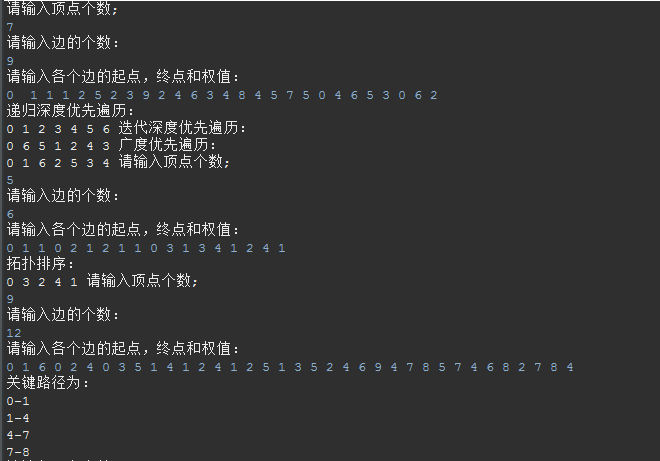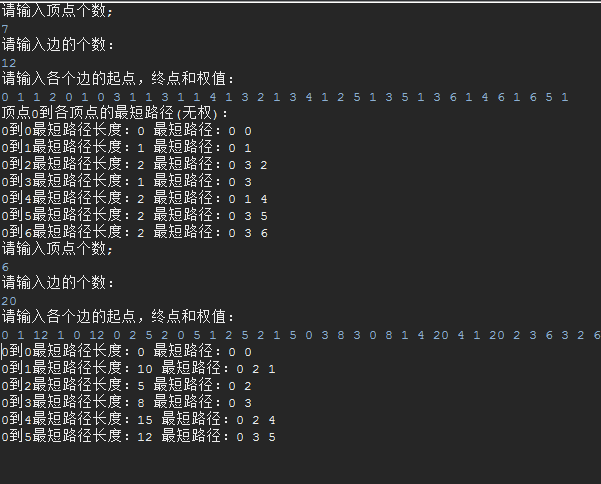邻接表存储图Java实现
2016-08-08 19:45
316 查看
/**
* 图的边结点类
* @author liangxiamoyi
*
*/
public class Edge {
/**
* 邻接顶点序号
*/
protected int verAdj;
/**
* 边的权值
*/
protected int cost;
/**
* 下一个边结点
*/
protected Edge link;
}/**
* 顶点表中的结点类
* @author liangxiamoyi
*
*/
public class Vertex {
/**
* 顶点序号
*/
protected int verName;
/**
* 边链表的头指针
*/
protected Edge adjacent;
}<pre name="code" class="java">import java.util.Scanner;
/**
* 邻接表存储的图
* @author liangxiamoyi
*
*/
public class Graph_List {
/**
* 指向顶点表的引用
*/
private Vertex[] head;
/*
* 当前顶点的个数
*/
private int vertexNum;
/**
* 构造方法
*/
public Graph_List(){
int e,from,to,weight;
Scanner sc=new Scanner(System.in);
System.out.println("请输入顶点个数;");
this.vertexNum=sc.nextInt();
this.head=new Vertex[this.vertexNum];
for(int i=0;i<this.vertexNum;i++){
head[i]=new Vertex();
head[i].verName=i;
head[i].adjacent=null;
}
System.out.println("请输入边的个数:");
e=sc.nextInt();
System.out.println("请输入各个边的起点,终点和权值:");
for(int i=0;i<e;i++){
from=sc.nextInt();
to=sc.nextInt();
weight=sc.nextInt();
Edge p=new Edge();
p.verAdj=to;
p.cost=weight;
p.link=null;
Edge q=head[from].adjacent;
if(q==null){
head[from].adjacent=p;
}
else{
while(q.link!=null){
q=q.link;
}
q.link=p;
}
}
}
/**
* 获得指定边的权值
* @param v1 顶点v1
* @param v2 顶点v2
* @return 权值
*/
public int getWeight(int v1,int v2){
if(v1==-1||v2==-1)return -1;
Edge p=head[v1].adjacent;
while(p!=null){
if(p.verAdj==v2)return p.cost;
p=p.link;
}
return -1;
}
/**
* 获得v的第一个邻接顶点
* @param v 顶点v
* @return 第一个邻接顶点的序号
*/
public int getFirstNeighbor(int v){
if(v==-1)return -1;
Edge p=head[v].adjacent;
if(p!=null)return p.verAdj;
else return -1;
}
/**
* 获得v1相对于v2的第一个顶点
* @param v1 顶点v1
* @param v2 顶点v2
* @return 顶点的序号
*/
public int getNextNeighbor(int v1,int v2){
if(v1==-1||v2==-1)return -1;
Edge p=head[v1].adjacent;
while(p.verAdj!=v2&&p!=null){
p=p.link;
}
if(p==null)return -1;
p=p.link;
if(p==null)return -1;
return p.verAdj;
}
/**
* 图的深度优先遍历
*/
public void depthFirstSearch(){
int[] visited=new int[this.vertexNum];
for(int i=0;i<this.vertexNum;i++){
visited[i]=0;
}
recDepthFirstSearch(0,visited);
}
/**
* 从顶点v出发深度优先遍历的递归算法
* @param v 顶点v
* @param visited 标识访问与否的数组
*/
public void recDepthFirstSearch(int v,int[] visited){
System.out.print(v+" ");
visited[v]=1;
int w=this.getFirstNeighbor(v);
while(w!=-1){
if(visited[w]==0){//若w未被访问过,从w递归访问
recDepthFirstSearch(w, visited);
}
w=getNextNeighbor(v, w);//w为v相对w的下一个顶点
}
}
/**
* 深度优先遍历的迭代算法
* @param v 起始顶点v
*/
public void iteDepthFirstSearch(int v){
int[] visited=new int[this.vertexNum];
for(int i=0;i<this.vertexNum;i++){
visited[i]=0;
}
AStack<Integer> s=new AStack<Integer>(20);
s.push(v);
int w;
while(!s.isEmpty()){
w=s.pop();
visited[w]=1;
System.out.print(w+" ");
int k=getFirstNeighbor(w);
while(k!=-1){
if(visited[k]==0)s.push(k);//没被访问过,压栈
k=getNextNeighbor(w, k);
}
}
}
/**
* 广度优先遍历的迭代算法
* @param v 起始顶点v
*/
public void broadFirstSearch(int v){
int[] visited=new int[this.vertexNum];
for(int i=0;i<this.vertexNum;i++){
visited[i]=0;
}
System.out.print(v+" ");
visited[v]=1;
AQueue<Integer> a=new AQueue<Integer>(20);
a.insert(v);
while(!a.isEmpty()){
int q=a.delete();
int p=getFirstNeighbor(q);
while(p!=-1){
if(visited[p]==0){
System.out.print(p+" ");
visited[p]=1;
a.insert(p);
}
p=getNextNeighbor(q, p);
}
}
}
/**
* 对含有n个顶点的AOV网进行拓扑排序
*/
public void topoOrder(){
int n=this.vertexNum;
int[] count=new int
;
for(int i=0;i<n;i++){
count[i]=0;
}
for(int i=0;i<n;i++){
Edge p=head[i].adjacent;
while(p!=null){
count[p.verAdj]++;
p=p.link;
}
}
int top=-1;
for(int i=0;i<n;i++){
if(count[i]==0){//将入度为0 的顶点入栈
count[i]=top;
top=i;
}
}
for(int i=0;i<n;i++){
if(top==-1){
System.out.println("a cycle in the network");
return;
}
int j=top;
top=count[top];//弹栈
System.out.print(j+" ");
Edge p=head[j].adjacent;
while(p!=null){//删除与j关联的边
int k=p.verAdj;
if(--count[k]==0){//k的入度减1,若为0则k入栈
count[k]=top;
top=k;
}
p=p.link;
}
}
}
/**
* 计算关键路径
*/
public void criticalPath(){
int i,k,e,l;
int n=this.vertexNum;
int[] ve=new int
;//事件的最早发生时间
int[] vl=new int
;//事件的最迟发生时间
for(i=0;i<n;i++){
ve[i]=0;
}
for(i=0;i<n;i++){//按拓扑顺序计算各事件允许的最早发生时间
Edge p=head[i].adjacent;
while(p!=null){
k=p.verAdj;
if(ve[i]+p.cost>ve[k])ve[k]=ve[i]+p.cost;
p=p.link;
}
}
for(i=0;i<n;i++){
vl[i]=ve[n-1];
}
for(i=n-2;i>=0;i--){//逆序计算事件的最迟发生时间
Edge p=head[i].adjacent;
while(p!=null){
k=p.verAdj;
if(vl[k]-p.cost<vl[i])vl[i]=vl[k]-p.cost;
p=p.link;
}
}
for(i=0;i<n;i++){//求各活动的最早开始时间和最晚开始时间
Edge p=head[i].adjacent;
while(p!=null){
k=p.verAdj;
e=ve[i];
l=vl[k]-p.cost;
if(l==e){
System.out.println(i+"-"+k);
}
p=p.link;
}
}
}
/**
* <p>无权单源最短路径算法</p>
* <p>求顶点v到其他各顶点的最短路径</p>
* @param v 顶点v
*/
public void shortestPath(int v){
int u,k;
Edge p;
int n=this.vertexNum;
int[] path=new int
;
int[] dist=new int
;
AQueue<Integer> q=new AQueue<Integer>(20);
for(int i=0;i<n;i++){
path[i]=-1;
dist[i]=-1;
}
dist[v]=0;
q.insert(v);
while(!q.isEmpty()){//将u的未访问的顶点入队,修改其path和dist值
u=q.delete();
p=head[u].adjacent;
while(p!=null){
k=p.verAdj;
if(dist[k]==-1){
q.insert(k);
dist[k]=dist[u]+1;
path[k]=u;
}
p=p.link;
}
}
for(int i=0;i<n;i++){
int w=i;
StringBuffer st=new StringBuffer();
st.append(i);
while(path[w]!=v&&path[w]!=-1){
int temp=path[w];
st.append(" "+temp);
w=path[w];
}
st.append(" "+v);
st.reverse();
System.out.println(v+"到"+i+"最短路径长度:"+dist[i]+" "+"最短路径:"+st);
}
}
/**
* <p>解决正权单源最短路径问题的Dijkstra算法</p>
* <p>求从初始顶点v到其他各顶点的最短路径</p>
* @param v 初始顶点
*/
public void dShortestPath(int v){
int u,k;
int max=1000;
Edge p;
int n=this.vertexNum;
int[] path=new int
;
int[] dist=new int
;
int[] s=new int
;//记录i是否被访问过
for(int i=0;i<n;i++){
path[i]=-1;
dist[i]=max;
s[i]=0;
}
dist[v]=0;s[v]=1;
p=head[v].adjacent;
u=v;//u为即将访问的顶点
for(int j=0;j<n;j++){
while(p!=null){
k=p.verAdj;
if(s[k]!=1&&dist[u]+p.cost<dist[k]){
dist[k]=dist[u]+p.cost;
path[k]=u;
}
p=p.link;
}
//确定即将被访问的顶点u
int ldist=max;
for(int i=0;i<n;i++){
if(dist[i]>0&&dist[i]<ldist&&s[i]==0){
ldist=dist[i];
u=i;
4000
}
}
s[u]=1;//访问u顶点
p=head[u].adjacent;
}
for(int i=0;i<n;i++){
int w=i;
StringBuffer st=new StringBuffer();
st.append(i);
while(path[w]!=v&&path[w]!=-1){
st.append(" "+path[w]);
w=path[w];
}
st.append(" "+v);
st.reverse();
System.out.println(v+"到"+i+"最短路径长度:"+dist[i]+" "+"最短路径:"+st);
}
}
//测试
public static void main(String[] args){
// 测试数据
// 7
// 9
// 0 1 1 1 2 5 2 3 9 2 4 6 3 4 8 4 5 7 5 0 4 6 5 3 0 6 2
// 5
// 6
// 0 1 1 0 2 1 2 1 1 0 3 1 3 4 1 2 4 1
// 9
// 12
// 0 1 6 0 2 4 0 3 5 1 4 1 2 4 1 2 5 1 3 5 2 4 6 9 4 7 8 5 7 4 6 8 2 7 8 4
// 7
// 12
// 0 1 1 2 0 1 0 3 1 1 3 1 1 4 1 3 2 1 3 4 1 2 5 1 3 5 1 3 6 1 4 6 1 6 5 1
// 6
// 20
// 0 1 12 1 0 12 0 2 5 2 0 5 1 2 5 2 1 5 0 3 8 3 0 8 1 4 20 4 1 20 2 3 6 3 2 6 2 4 10 4 2 10 2 5 8 5 2 8 3 5 4 5 3 4 4 5 9 5 4 9
Graph_List g=new Graph_List();
System.out.println("递归深度优先遍历:");
g.depthFirstSearch();
System.out.println("迭代深度优先遍历:");
g.iteDepthFirstSearch(0);
System.out.println("广度优先遍历:");
g.broadFirstSearch(0);
Graph_List gl=new Graph_List();
System.out.println("拓扑排序:");
gl.topoOrder();
Graph_List gr=new Graph_List();
System.out.println("关键路径为:");
gr.criticalPath();
Graph_List gs=new Graph_List();
System.out.println("顶点0到各顶点的最短路径(无权):");
gs.shortestPath(0);
Graph_List gt=new Graph_List();
gt.dShortestPath(0);
}
}测试结果:


相关文章推荐
- 邻接表存储图,DFS遍历图的java代码实现
- 邻接表存储图,DFS遍历图的java代码实现
- 使用Java实现在SQLserver中实现图片的存储
- 使用Java实现在SQLserver中实现图片的存储
- 用oracle的java存储过程实现BLOB字段的字符串读取
- Java 内存数据存储缓冲区虚拟实现
- 图的邻接表存储 深度优先遍历 广度优先遍历 C语言实现
- 在JAVA中实现数据库存储过程的统一调用
- java实现树(链式存储)
- 用oracle的java存储过程实现BLOB字段的字符串读取
- 图及其算法复习(Java实现) 一:存储结构,深度优先周游,广度优先周游
- 无权图无向图【邻接矩阵存储】深度搜索和广度搜索--Java实现
- 使用Java实现在SQLserver中实现图片的存储
- 使用Java实现在SQLserver中实现图片的存储
- 使用Java实现在SQLserver中实现图片的存储
- 用oracle的java存储过程实现BLOB字段的字符串读取
- 使用Java实现在SQLserver中实现图片的存储
- JAVA实现:给出洗牌的一个算法,并将洗好的牌存储在一个整形数组里
- 存储过程调用,java中通过bboss persistent实现数据库存储过程的调用(命名变量绑定)
- 用邻接表表示图【java实现】
